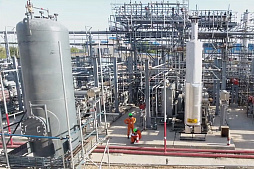After receiving the necessary documents (application form and project presentation), our team will try to review your request as soon as possible, and leading experts will offer the best options for project funding.
The implementation of new projects in this area requires the attraction of long-term sources of cheap funds, which is associated with professional financial modeling and investment consulting services.
Creating a financial model for a waste processing plant plays an important role in attracting funding and allows participants to achieve optimal results in terms of profitability and other fundamental indicators.
The financial model can be used in many areas, including the following:
• Search for funding sources.
• Optimization of production and storage of products.
• Making decisions on the supply of waste, energy, equipment, etc.
• Assessment of project risks and their minimization.
• Determination of the break-even point.
• Modeling of depreciation processes.
• Project cash flow management.
• Changes in the capital structure.
• Business expansion, etc.
Waste management is a complex and multifaceted business activity with many variables and risk factors.
The business environment for recycling and generating energy from waste is constantly changing, not forgiving mistakes. Here, as in no other industry, a professional approach and informed decisions are important.
Financial experts of ESFC Investment Group conduct a comprehensive study of each project and offer each client a customized approach. Our task is to offer affordable funding and choose a model that has the maximum positive impact on the outcome of the project.
We offer our clients financial instruments that are best suited to their specific business and can become the dominant model for a new waste processing plant and its infrastructure.
Creation of a financial model of a waste processing plant
Financial modeling is used primarily when developing a business plan and planning the financial structure of a future company, plant or other project.The task of modeling is to transform predictive indicators and scenarios into an abstract model that provides a visual representation of the business to its owners, potential partners, lenders and investors.
Essence of financial modeling
A financial modeling service can be defined as an attempt to convey the structure of a plant (sources of revenue, costs, capital structure, and external factors that affect financial performance) as a set of spreadsheets that reflect any changes in variables and show the consequences of those changes.The complex model contains profit and loss statements, a balance sheet and a calculation of the project's financial flows and indicators with relationships between them.
Financial models can be successfully used both in the case of SMEs and in the development of a large waste processing plant project, designed for several thousand tons of waste daily.
The main difference is in the complexity of modeling and the potential cost of errors.
A qualitative model allows companies to predict the impact of any changes in the external or internal business environment on its financial results. Since financial models are developed taking into account the analysis of historical data, a professional team can present to the customer several different scenarios with variables that cause changes in the entire structure.
Before making any financial or investment decision, this model allows project participants to predict the development and consequences of each of the scenarios. This is an important tool in the financing of waste processing plants, affecting the capital structure and sources of its financing.

Advantages of the financial model for large businesses
A well-thought-out financial model provides many benefits for both business owners and potential partners.This is especially the case for capital-intensive waste management and WtE projects, where product price fluctuations, along with unsteady regulatory frameworks, create additional risks.
Modeling facilitates strategic decision making. From the moment when the consequences of a change in any financial factor are reflected visually on the chart, a mechanism for making a new decision is launched. The possible impact of changes in prices for secondary raw materials, wages, interest rates can be seen immediately after changing the corresponding variables inside the table.
Flexibility is an important advantage.
Experienced teams can easily change typical financial models to fit the new realities of the waste treatment plant (for example, switching to a new type of fuel or generating energy from waste).
When there are sudden changes in production conditions, the model can be adjusted to the new reality.
Thus, the business is ready to respond flexibly to changes and manage them based on a mathematical model and forecasts.
Electronic financial modeling for large projects
Professional financial models are usually developed in Excel, although there are now a number of alternative enterprise resource planning (ERP) and business intelligence (BI) software, as well as business modeling tools using programming languages.The reasons for the popularity of the electronic financial model are simple and obvious:
• The spread of the MS Office suite has made spreadsheets on this platform widely known in the banking sector and business circles around the world. It is easy to find a consultant who is familiar with the modeling technique in Excel.
• Office applications are the most simple and affordable solution for literally every person who knows how to use a computer.
• The flexibility of electronic financial models allows you to design the capital structure and financial flows of a waste processing plant and almost any other large enterprise without excessive costs. Moreover, specially adapted software solutions today are ways to program the model of a multinational company with its hundreds of representative offices in different countries of the world.
However, it should be remembered that financial modeling requires a thorough understanding of economics, finance, and accounting.
A qualitative model is a mathematical representation of reality, accurate and multifaceted. It should not miss a single significant factor, but at the same time it should be clear and transparent so that the user can adapt the model to any situation.
Financial modeling is structured in several stages:
• Collection and input of primary information into spreadsheets.
• Performing financial calculations based on the collected information.
• Development of dynamic graphs and charts for better visualization of information at meetings and presentations with project partners.
Depending on the business environment, information will be collected from other applications, data warehouses, and different departments. All this data needs to be sorted, classified and prepared for integration into the final model using software tools.
Risks and limitations of financial modeling
An electronic financial model of a waste processing plant will only benefit the customer if it is prepared and used correctly.If the model contains false or inaccurate assumptions that do not take into account variables important to the enterprise, the cost of such errors can be very high.
Business knows examples when seemingly promising investment projects crashed against the harsh reality at the stage of searching for sources of financing. Some projects died during the construction phase, turning into a costly and useless concrete monument to financial mistakes and miscalculations.

Since the financial model can be the basis for making important decisions, any unrealistic assumption can lead to the wrong decision. Investment planning, long-term or medium-term profitability planning cannot be based on a defective model.
Table: Main risks of financial modeling.
| Type of risk | Description and possible consequences |
| False data or assumptions | A financial model built on false data leads to wrong decisions. This can lead to the bankruptcy of the customer and even to legal proceedings if the data is falsified by the contractor. |
| Erroneous calculations | Errors in financial formulas (usually made at the stage of processing an electronic model) lead to incorrect results, despite the qualitative collection of information. This reduces confidence in the model and forces customers to abandon a potentially correct financial instrument due to mathematical problems. |
| Oversimplification | To avoid mistakes when modeling very complex business processes, there is a trend towards oversimplification. Such simplification can lead to insufficient consideration of influencing factors and wrong decisions. |
Interesting fact: the Institute of Chartered Accountants in England and Wales recently published a report showing that 9 out of 10 spreadsheets contain errors, including methodological errors.
Financial modeling for waste processing plants is a complex matter that should be left to the experts.
It's also a matter of trust.
If you need reliable specialists, please contact ESFC.
The importance of a professional approach
For a waste processing plant, important production parameters such as the volume of waste processing, the volume of production of secondary raw materials, the exact ratio of the output components, as well as the consumption of electricity and gas and other items of operating costs should be taken into account.These specific data allow specialists to more accurately calculate the financial results of the project in the medium and long term, choosing the appropriate ways to finance the investment project.
The basis of the financial model of the waste processing plant is the balance sheet and cash flow information.
Depending on the structure of the enterprise, the development of the financial model is complicated by the associated waste storage and processing infrastructure, the elements of which have separate models and require smooth integration into the main model.
Financial models could become much more complex than originally thought.

Too much complexity often leads to the same errors as an incomplete or unrealistic model. In practice, this means that experts must classify, filter and bring the source data and formulas in full compliance with the requirements of a particular customer.
Considering the high level of complexity, together with the risks of financial modeling described above, it becomes clear that a high-quality result can only be achieved with professional support. Some companies spend hundreds of thousands of euros on maintaining large departments, purchasing advanced software products and financial analysis of projects in-house.
How correct is this approach for modern businesses?
World experience shows that spending the company's internal resources on such tools is less effective than hiring third-party specialists with the appropriate knowledge and reputation.
If you are interested in financial modeling services from European professionals with over 20 years of experience, please contact ESFC Investment Group. Just state your wishes for the project and get to know the benefits of our services.
Our financial / investment services for medium and large businesses
The financial model is important for both the project initiators and the investor.The company must have a clear vision for its business.
Any investor wants to know where he is investing his money.
With the receipt of external financing, whether it be a loan or an investment, the financial model becomes a strategic planning tool.
Investors expect from their partners transparent, complete and correct presentation of the situation, especially the situation with income and liquidity.
ESFC Investment Group, a Spanish company with rich international experience, offers a wide range of services for large corporate clients in Europe and outside the EU.
We help to realize multi-million dollar projects in the field of renewable energy, waste processing, heavy industry, agriculture, oil production, mining, real estate and other sectors.
Our professional services include but are not limited to:
• Investment financing of 50 million euros or more.
• Investment consulting for large companies and projects.
• Organization of project finance (PF).
• Financial modeling and forecasting.
• Letters of credit and bank guarantees.
• Engineering and research.
We have been involved in large projects in Spain, Germany, France, Brazil, Argentina, Mexico, Saudi Arabia and other countries around the world.
Our advanced financial technologies, extensive business contacts, professional experience and impeccable reputation will be the key to the success.
For details, you can contact our office in Girona (Spain) or contact a representative of ESFC Investment Group to schedule a consultation at any convenient time.






















